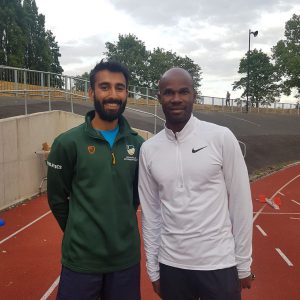November 20, 2018, by Prof Meghan Gray
Makun’s summer internship in Cambridge
Guest post by Makun Madar (MSci Honours Physics with Astronomy) about his research experience over this past summer — by coincidence working under the supervision of another former Nottingham undergraduate! A student-athlete, Makun juggles his academic work with being President of the university athletics club.

Makun standing next to former world 100m champion Kim Collins.
The summer between my third and fourth year was spent at the Institute of Astronomy at Cambridge University. At the IoA I undertook a project supervised by Dr Helen Russell. The summer placement taught me skills that will help me in my master’s year and beyond. It gave me an insight into what a research project involves and the kind of mindset a physicist requires.
The title of my summer project was “Stimulated feedback and jet driven outflows in massive galaxies”. I studied the galaxy NGC708 in the Abell 262 galaxy cluster using data taken from ALMA (Atacama large millimetre/submillimetre array). This radio-loud galaxy’s molecular clouds about the nucleus were analysed to determine how the active nucleus affected the host environment, whether the radio jets heat and expel the surrounding cold gas to suppress star formation, regulating the central SMBH growth or whether the radio bubbles stimulate the formation of cold gas by triggering thermal instabilities in warmer uplifted gas.
For the duration of this two-month project I covered a wide range of aspects involved in research. The project was structured so I get a taste of everything as a usual research project can last years on end. A large portion of the project was learning how the computing system worked as this was a largely computational based project. At uni I’m used to simply running everything on a computer that using Windows, at Cambridge the most efficient way to access everything was through a terminal window. I had the opportunity to learn Python as this was the code used for all the image processing. I also learnt how to use CASA (Common Astronomy Software Applications), a software package which analyses astronomical radio sources.

Hubble optical image of galaxy with contours of the central molecular gas superimposed.
The environment at the institute really surprised me, twice a day in the morning and afternoon all the students and research fellows meet to have tea and coffee (and a lot of biscuits)! This was a great opportunity to network and find out what’s going on in the world of physics. The institute is split into groups depending on the area of research, I was involved in the X-ray group. Every Friday the X-ray group met for cakes and to review all the related research papers released throughout the week and for other members of the group to talk about their current projects. I attended multiple guest talks from guests all over the world!
No comments yet, fill out a comment to be the first

Leave a Reply